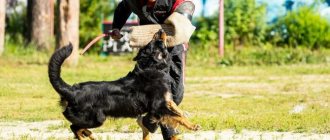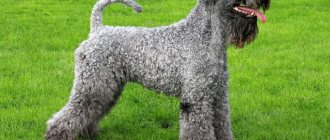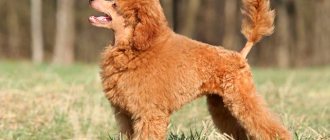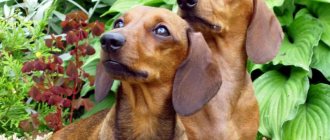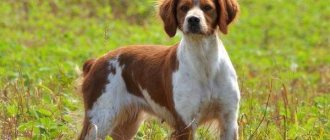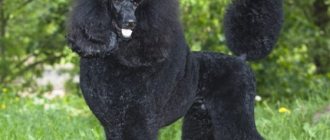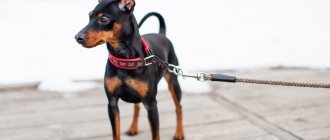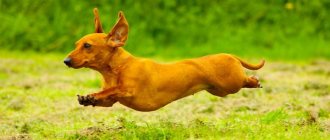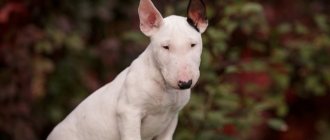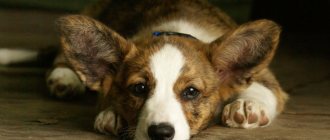| Origin: | England (XVI century) |
| Usage: | hound in a pack for mounted hunting |
| Color: | white with black spots in blush, lemon piebald |
| Dimensions: | height – 58-64 cm; weight – 27-34 kg |
| Lifespan: | 10-13 years |
The English Foxhound is a breed bred on the British island in the 16th century for fox hunting. Also known as Parfors foxhound. Popular in England. The stubbornness and courage of an unsurpassed hunter, intelligence and speed of movement made this breed popular. English foxhounds became the ancestors of similar dogs in other countries (including the famous Russian pinto hound).
Breed standard
The English Foxhound, with all its variety of subtypes, has the following general standards:
- elongated muzzle with a wide and rounded skull;
- a regular scissor bite with a full set of incisors and strong jaws;
- brown or hazel color of expressive eyes;
- drooping long ears with rounded ends;
- smooth, long neck without folds or wrinkles;
- wide and developed lower back;
- the chest is not muscularly massive, but it is quite deep;
- the tail is raised and slightly curved;
- the paws are well developed, they are strong, straight and strong;
- the shoulders are powerful, but not bulky;
- different colors, with spots, the color of which is often black;
- The coat is short but dense.
The description of the breed and numerous photographs demonstrate the strong and harmonious build of the English Foxhound with smooth, free and fast movements. Characteristics of the breed suggest the height of females from 58 cm, males - from 62 cm with a weight that rarely reaches 30 kg.
Appearance
The English Foxhound is a powerful, well-balanced dog of pure lines, often tri-colored. Sexual dimorphism is moderately expressed. Height at withers is approximately 56-64 cm.
The standard of the English Foxhound is very laconic. Despite this, the dogs are surprisingly typical and to this day remain exclusively working dogs.
The head is well balanced. The skull is of medium width, flat. The muzzle is square, long, with moderately developed cheekbones. The nose is large, with wide open nostrils. Stop is expressed moderately. The jaws are strong and have a scissor bite. The eyes are medium size, brown in color. The ears are hanging, set high, pressed to the head.
The neck is slightly curved, long, and well developed. The body is strong, the muscles are very well developed, prominent. The back is straight and wide. The loin is somewhat convex and strong. The chest is deep, the ribs are rounded. The tail is set high and never curls over the back. The forelegs are straight, long, with good bones. Hind limbs with well-developed muscles and bones, powerful. The feet are dense, rounded, strong, with strong nails and pads.
The coat is dense and short, any color recognized among hounds. Most often, the English Foxhound is a tri-color color: white with red markings and a saddle on the back.
Character
The English Foxhound has a friendly and sociable character. Dogs of this breed are curious, intelligent and very attentive to everything that surrounds them. They are distrustful of strangers, but they love and protect their owner’s family.
The English fox hound has an excellent sense of the pack. With other pets, even cats, the Foxhound is friendly and playful.
The English Foxhound may begin to hunt small pets, so it is better to limit their interaction.
These dogs are careful around children. They are tireless and take part in all active children's games and pranks.
The sociability of Foxhounds is manifested in a loud, booming bark, which is genetically determined. Barking helps in hunting, but in keeping it can become a problem.
The best breeds of hound dogs
Hunters, in addition to their professional qualities, are friendly. They get along well with people and animals. Anyone who wants to own a hound will be able to choose a suitable breed from a large list.
Austrian smoothhair
The breed appeared in Austria and did not gain popularity outside the country. Suitable for hunting in rocky terrain. The animal is capable of chasing prey for hours and takes birds and small game well. By nature, they are loyal, savvy, peace-loving and reserved dogs. They can be kept in a city apartment. Easy to train.
Alpine dachshund braque
Representatives of this breed first appeared in Austria. They are able to hunt in forests and steppes. They track the victim by smell or bloody trail, and then give a signal to the owner. They are distinguished by ingenuity, devotion, and courage. But they are characterized by aggression and disobedience, so the owner must be strict and constantly work on raising the pet.
English Foxhound
It is considered an example of a classic hunting breed. It was developed in the 16th century in Britain. It was used during noble fox hunting on horseback, but can also be used to corral wild boar or deer. In most cases it is used as part of a pack. On rough terrain it accelerates to speeds of up to 25 km/h.
The body weight of the English Foxhound ranges from 27-34 kg, the height at the withers is from 58 cm to 64 cm. The coat is short and hard. Color can be varied, but white covers up to 25% of the dog's body. These even-tempered, friendly pets are wary of strangers. They get along well with children and other animals. They are obedient and very smart. They can be presented at exhibitions.
Anglo-Russian hound
This breed is also called Russian Piebald Hound. She was bred in Russia by crossing an English Foxhound and a Russian Hound. Used to corral hare, wolf, roe deer. It has good instincts and endurance. Can be used in forests and plains. Most often used to work in pairs.
Representatives of this breed need patient, persistent owners; they obey only confident trainers. Anglo-Russian hounds become attached to the family in which they live. They are distinguished by kindness, passion, and patience.
Anglo-Russian hound
English Foxhound
Alpine dachshund braque
Ariège Hound
Representatives of this breed are called Ariegeois. Bred in the south of France. These are very hardy dogs, capable of tracking prey for hours. Typically used for hunting birds and hare, for rutting in fields, forests and rocky areas. Ariegeois are playful and agile. They understand people well and are easy to teach.
Basset Hound
The breed was bred in England. These are dogs with good instincts and a keen sense of smell. They are used for hunting small game in forests and plains. The Basset Hound is active, playful and adventurous. You can have him not only for hunting, but also as a companion. But in this case, it is better to keep the pet in a private house or outside the city so that it has the opportunity to move a lot. Training is required.
Beagle
These are medium-sized, up to 11 kg, burrowing dogs. Beagles are mobile and independent. It is important to educate them from an early age, since representatives of this breed are characterized by willfulness and stubbornness. Beagles are usually three or two colors. Single-colored dogs are rare. Thanks to their excellent sense of smell, they not only successfully track down prey, but are also used at customs and are good at detecting explosives.
We recommend the article: Characteristics of the Beagle dog
Bloodhound
Developed in Belgium, where it was used both for hunting and detective work. Has proven itself well in corralling foxes and small game. Animals can work in open areas and in difficult places. The name of the breed can be translated as “dog of blood.” There are two versions of the origin of the name. On the one hand, the ability of dogs to track wounded animals along a blood trail is taken into account. On the other hand, the emphasis is on the purebred bloodhounds.
Large Anglo-French tricolor hound
One of the rarest breeds of hound dogs, bred in France. The colors of dogs of this breed are black and white, orange and tri-color. These are friendly, loyal dogs. They are smart and easy to train. They work well alone and in pairs. Thanks to their endurance, they are able to follow a victim for hours and can track down a wounded animal. They are used when hunting large animals.
Great Blue Gascony Hound
A rare, uncommon breed, bred in the Middle Ages in France. Its representatives are considered one of the most beautiful among hounds. They are distinguished by strict proportions and beautiful wool with a blue tint. These hunters have keen eyesight and sense of smell. They adapt to bad weather and follow the trail for a long time. They are used in hunting small and large animals.
Blue Gascony Hounds are intelligent and resourceful, but they are stubborn and need to be trained from a very young age. Otherwise they will be uncontrollable.
Great Blue Gascony Hound
Large Anglo-French tricolor hound
Bloodhound
HamiltonSteware
A Swedish breed that is suitable both for hunting and as a companion. Its representatives have a keen sense of smell and can follow a scent for several hours in any terrain. They are set against small animals. Hamiltonsteware are peaceful, friendly, and well trained. They love children and can be kept in a city apartment. They showed themselves well as a watchman.
Blue Gascony Basset
This breed was developed in France from the Blue Hound. It has proven itself well when tracking hares on the plains, but can also be used in forests. It has a keen sense of smell, hunting instincts and a loud voice. Representatives of this breed get along well with people and other animals and can be kept in city apartments. Characterized by restraint, calmness, kindness.
Dalmatian
Drawings of Dalmatians were found during excavations in Greece. This gives reason to assert that the breed is several thousand years old. The spread of Dalmatians began in Croatia. These dogs can be hunters, companions and watchdogs. They have a keen sense of smell, endurance, and courage. Capable of tracking large game among rocks or in forests. Dalmatians are kind and intelligent and are easy to train.
Dunker
The second name of the breed is Norwegian hound. It was bred in Norway in the 19th century to hunt hares. Dunker finds the victim, drives the owner out to the gun and brings the killed animal to the person. Representatives of this breed do not give up chasing game, despite difficult weather conditions, be it extreme heat or frost. These are active, playful, agile dogs. They are friendly, loyal, and completely non-aggressive.
Spanish hound
She is also called Sabueso Español, which translates as “snoop.” The breed was bred specifically for hunting and detective work. Therefore, dogs easily find a common language with people, but are not fans of affection. In addition to hunting, Spanish hounds are used to search for drugs and detain criminals.
Italian hound
One of the oldest European breeds. It is often used to breed new varieties. Italian hounds perform tasks on any terrain and in any weather conditions. They are used for hunting large and small animals. These dogs are characterized by passion, loyalty, friendly disposition, and sociability.
Italian hound
Spanish hound
Dunker
Nivernaise Griffon
Representatives of this breed are also called boar hounds. Used for hunting animals of any size. There are known cases of baiting wolves and grizzly bears with their help. Suitable for hunting among rocks. Griffons are calm, loyal, smart and obedient. But they need to move a lot. It is important to educate them all the time.
Poitevin
The breed originated in France. Due to the rabies epidemic, most of the representatives of this breed died. The population was gradually restored through the efforts of breeders. Poitevin is used to corral wild boars, foxes and even wolves. These are large dogs up to 70 cm tall. They have a keen sense of smell and can follow a scent for a long time. They are easy to train, attentive and patient.
Polish ogar
Polish hounds are good at tracking prey by smell and bloody trail, and are able to dodge attacks. Used to corral deer, wild boars and foxes. These sociable and friendly dogs are easy to train.
Rhodesian Ridgeback
The second name is African Lion Hound. Only this breed passes through all classifications as a hound. Capable of hunting large animals and even predators. It navigates well on flat terrain and adapts to any climate. Having tracked prey by smell, it can engage in combat with it. These loyal, obedient dogs are best kept outside the city.
Russian hound
An original Russian breed, dating back to the 11th century. Used to corral hares, foxes, wolves and wild boars. In most cases, these dogs are used in groups. They are distinguished by their ability to track wounded animals. Among the hound breeds, this is not the fastest, but its representatives can work in any weather conditions.
Serbian hound
Another name for the breed is the Balkan hound. It was brought to the Balkans by merchants from Asia Minor. There, dogs adapted to the climate and terrain and began to be used for hunting wild boars and deer. They work well among rocks and in the forest. These smart animals are easy to train.
Slovakian hound
These are hardy and persistent dogs. They are used as hunters and guards. They performed well in all weather conditions; they navigate best on the plain and among rocky terrain. These peaceful, sociable animals can be kept in a city apartment. But in this case you need to spend a lot of time walking.
Slovak
Serbian
Russian
Smålandstevare
This Swedish breed was formed without human intervention and is one of the most ancient. The Smoland Hound is easy to train, has endurance, and is able to work in any weather. Showed itself well in tracking hares and foxes. He is distinguished by his patience, gentleness, and love for children.
Despite the small size of dogs of this breed, it is not recommended to keep them in apartments, as they are very active and need constant movement.
Porcelain hound
It is also called the noble royal hound. This is a rare species of hunters, sent to hunt small animals. Maybe go for the wild boar. Porcelain hounds work alone or in pairs. If you keep these active dogs in an apartment, they need to be constantly trained and walked for a long time.
Finnish hound
Scandinavian breed, the second name of which is Soumenajokoira. Can track a hare, raccoon, elk, fox. It has a keen sense of smell and eyesight. Able to work in cold weather, but only alone. During the hunt, it moves away from the owner, chases the prey, and then notifies the person by barking. Finnish hounds need constant exercise, games, and walks.
Haldenstever
Norwegian hunting and family breed. Developed in Norway in the 20th century. Prized for its excellent hunting qualities. He can become a good companion, as he is strongly attached to people, shows goodwill, and has a gentle character. Outside of hunting, the dog needs constant training and exercise.
Harrier
Another name is hare hound. An active, hardy dog with a keen sense of smell. Can hunt wild boar, fox, game. Harriers often show stubbornness, so you need to constantly educate and train them.
Swiss hound
Images of the Swiss hound were found on frescoes from the time of the Roman Empire, but the first mention of the breed dates back to the 17th century. Dogs of this breed can be used for hunting among fields and on the plain. The gonchak has a special way of tracking its prey and can cover long distances. These intelligent dogs have good intuition and are very sociable.
Swiss hound
Harrier
Haldenstever
Swedish dachshund marriage
This breed was bred relatively recently, its second name is Drever. Used in Scandinavia for hunting hares, foxes, roe deer and wild boars. Drevers are often taken as companions. They are friendly and good with children, but they constantly need physical activity.
Anyone who wants to own a hound can choose the appropriate option from a long list of breeds, based on the exterior, character and animal. It is important to remember that a hunting dog needs to be provided with an active life, including not only physical, but also mental stress.
Recommended Posts
TOP 40 best hunting dog breeds with names, descriptions and photos
Review of the 30 most beautiful dog breeds in the world with names and photos
38 best dog breeds for apartments according to reviews from breeders and owners
The main differences between the Estonian hound and the beagle
20 best guard dog breeds with names and photos: choice of dog handlers
TOP 25 most fluffy dog breeds in the world: names, descriptions and photos
Features of maintenance and care
The Foxhound dog breed is unpretentious. This is a pack dog, so it is best to keep several hounds at a time. The peculiarities of keeping them are that foxdogs need to be walked for a long time, like any hunting dog.
Walk
Walking on a leash is not suitable for a Foxhound. He needs space to be able to release pent-up energy. It is best when the owner is interested in hunting and uses the dog for its intended purpose, periodically training the pet and developing in it the natural instincts of a hunter. But you should be careful, as a fox hound may get carried away while walking and follow the animal’s trail.
Combing
Grooming for the foxhound dog's coat is minimal. Twice a year they shed profusely. During this period, dogs should be brushed daily to speed up the process. The rest of the time, once a month will be enough.
Bathing
You should not bathe your Foxhound frequently. Only if necessary, if the pet got very dirty during a walk. If the dog lives in an enclosure with a warm booth, it will be enough to wipe the fur with a dry cloth after a walk.
Feeding
With natural feeding, you will have to additionally give your English Foxhound a complex of vitamins. If the choice is made towards specialized feeds, then this will not be required, since everything necessary is already included in their composition.
The Foxhound is an active dog, so it expends a lot of energy. The diet of a pet of this breed should be selected taking into account its mobility.
Features of hunting
Working with pointing dogs is the oldest fishing method. It was once the privilege of the wealthy aristocracy. Not everyone could afford to keep a pack of dogs.
For mining it is used:
- one dog;
- bow of 2-3 individuals;
- small pack (up to 5-7 dogs);
- big pack.
The most effective pair is a monobreed coupling of a female and a male. The dog is more aggressive towards the animal. The opposite sex hunts responsibly and patiently. They complement each other harmoniously.
The following are considered important qualities:
- viscosity;
- running speed;
- developed sense of smell;
- acute hearing;
- sonorous voice.
Each hound breed has specific characteristics of hunting a particular animal. Depending on the fishery there are:
running gear, when the shooter, the dogs are constantly on the move, chasing prey; a motionless hunt, during which the animal is driven out to a certain place where shooters and hunters are hidden.
One of the characteristic features of hunting with hounds is the services of a huntsman. He knows the area, fauna, and habits of wild animals well.
Health
The English Foxhound has excellent health, which has been improved over several centuries of selection. There are practically no hereditary diseases in the breed. On average, Foxhounds live from 10 to 13 years.
Possible diseases
Thrombocytopenia is a breed health problem that occurs occasionally.
When choosing a puppy, you should make sure that his ancestors did not suffer from hip dysplasia.
It is very rare, but such an unpleasant hereditary disease as von Willebrand disease also occurs. Sometimes English Foxhound dogs can suffer from eye diseases.
Vaccinations
Foxhounds should be vaccinated once a year against rabies and a range of other infectious diseases. This is especially true if the dog is used for hunting, because wild animals can be carriers of a variety of infections.
Periodic treatment of your pet against parasitic insects and helminths is also required.
History of the English Foxhound breed
The breed was developed in England in the 16th century and is one of the most famous English hounds. In the middle of the 17th century, representatives were brought to America, where the American Foxhound was developed on their basis. Subsequently, the breed was often used in the selection of new representatives of the hound group, including in Europe and Russia.
Fox dogs received recognition first in the United and American Kennel Clubs (in 1905), and later within the framework of the International Canine Federation (1955). At the same time, an official standard appeared. Thus, from their appearance to worldwide recognition, English Foxhounds existed for more than 4 centuries. Today the breed has several popular names; representatives are often called English parathas or fox hounds.
The breed received the name “fox hound” because it was most often used for fox hunting.
How to choose a puppy
The first thing when choosing a puppy is to focus on the conditions in which the litter is kept. The baby must be strong, active and well-fed.
You should not buy a puppy before two months of age. It is better to choose an animal in person rather than online. The puppy must have all breed standards - this should be checked immediately, paying special attention to the bite, the number of incisors, the proportionality of the build and the shape of the paws, which should be straight.
Before buying, you need to look at the documents for the dog, check the pedigree of the parents and the presence of the necessary vaccinations.
Characteristic
The Irish Terrier is a universal dog, a family favorite, a guard and an indispensable assistant to the owner. Can be a hunter and gun dog. Belongs to the terrier group, does not pass working tests.
FCI breed standard: No. 139
An active and lively dog is proportional and does not show clumsiness when moving. It has a long head with a flat, rather narrow skull and a barely noticeable stop. The muzzle is moderately wide, without narrowing. The nose is black, fully pigmented.
The Irishman's cheekbones are moderate, but his jaws are quite long and strong, providing a good grip. The teeth are straight - the upper ones are slightly pushed forward, overlapping the lower ones. Dry lips adhere tightly to the teeth line.
The eyes are small and dark in color – light or yellow are undesirable. You can read curiosity, fire and interest in life in your gaze. The infraorbital areas protrude barely noticeably. Small ears are set high on the skull, the tips hang forward, reaching to the temporal region.
The neck is dense and long, set almost vertically, there is no dewlap. The neck widens towards the shoulders, turning into strong shoulders. The back line is straight, the loin protrudes slightly, the croup is completed by a saber-shaped tail set vertically, covered with coarse hair without fringes. Some dogs have their tails docked.
The terrier's chest is dense, but not too wide, and the ribs are long. The limbs are set parallel, the hips are powerful. The hock joints of the hind legs are set low.
Breed faults:
- cowardice;
- aggression;
- under/undershot;
- depigmentation of the lobe; any shade except black;
- color deviation from those specified by the standard;
- cracks on the paw pads.
Obvious physiological or psychological deviations from the standard. Any defect leads to the exclusion of the dog from breeding.
Irish Terrier – dog photo, character description
Dimensions, weight and height of the breed
The height of the Irish Terrier is 45.5 cm, according to the standard. Minimal deviations are acceptable. Males weigh more than females - about 12.2 kg, the latter's weight is 11.4 kg.
Possible colors
The Irishman's coat is short and broken, reminiscent of twisted wire in structure. It fits so tightly to the body that even if you pull the skin apart with your hands, you won’t see the skin. The head and limbs are covered with shorter hairs, straight and smooth. There should be no curls in the coat. The maximum length of hair is on the beard and mustache of a terrier.
Color options:
- wheat with red rye;
- bright red;
- golden with a red tint.
Any color may have small white spots on the sternum.
Puppy weight by month
Irish Terrier puppies are born weighing about 225 g. They actively gain weight at the very beginning of life.
Approximate age to weight ratio:
- 1 month – 1.1 kg;
- 2 months – 2.5 kg;
- 5 months – 6 kg;
- 8 months – 9 kg;
- 11 months – 9-11 kg.
The given parameters are approximate, the weight depends on the genetics of the puppy and the number of babies in one litter.
Lifespan
The life expectancy of the Irish Terrier is encouraging - on average, a representative of the breed lives 13 years with good quality, but often breeders note cases of longevity - up to 17 years. In old age, the dog becomes a little grumpy, but does not lose his vigor.
Allergenicity
The Irishman's shedding is weakly expressed - the separation of the epithelium of the skin and undercoat is insignificant. This means that the breed is less likely than others to cause allergies. However, there are no completely hypoallergenic dogs, so before buying a puppy it is better to get tested and closely interact with the terriers of other owners.
Irish Terrier description of dog breed, characteristics
Nurseries
The English Fox Hound is a fairly rare breed outside of Britain. There are now about 300 working packs on the island where puppies can be purchased. A number of packs of Foxhounds can be found in Germany and Canada. But in Canada, English foxhounds are often mixed with American hounds, so the breed is rarely preserved there in its pure form.
People with an energetic personality type should buy an English Foxhound. This is a working breed, so this dog is not suitable for the role of just a pet. In addition, there are also difficulties in content. The animal requires excessive mobility, flocking, and frequent and long walks. However, for a keen hunter living in a country house, this is a suitable pet, a faithful assistant, and a friend.
Price
It is better to buy a Gascony hound from a kennel. The breeder provides you with a passport for the puppy, which indicates: the animal’s pedigree, its color, gender, vaccinations, etc. The cost of an animal from a nursery will be more expensive than purchasing it through an advertisement.
The price for dogs varies:
- If the animal is from a nursery, then a large breed will cost from 20 thousand rubles, a small one - from 15 thousand rubles.
- If the animal is purchased through an advertisement, then the cost of a large dog will be from 15 thousand rubles, a small one - from 10 thousand rubles.
Raising and training the breed
The American Foxhound is a very obedient dog, but only in the hands of experienced owners, i.e. this is not a dog for a beginner. In inexperienced hands, this dog turns into an uncontrollable and disobedient dog. In its hunting frenzy, this is simply an uncontrollable dog; if it has attacked the scent of, say, a fox, then it can no longer escape the sensitive nose of the American Foxhound.
It is extremely important for a dog to engage in hunting or similar forays into the forest or nature. Experienced hunters claim that the dog soon gets sick if it does not have enough physical activity.
During training, the owner should be persistent and demanding, as any indulgence will be noticed and the dog will stop obeying. Hounds have an excellent “smell” for such things. You can use various methods other than physical influence. If you beat a dog, he will become embittered or become timid and cowardly.
American Foxhound Care
American Foxhounds are very noisy dogs. This dog cannot be called a pet; it needs country space and a flock of its own relatives. Caring for an American Foxhound involves regular brushing of the coat.
The American Foxhound is a true hunter who does not want to live within four walls. Frequent walks are necessary; if it is not possible to go hunting, it is better to keep the dog in an enclosure.
A lot of exercise is required and regular brushing of the coat is necessary.
Dogs of this breed have a hard, short coat, and periodic brushing is sufficient to care for it. The coat protects Foxhounds well from the weather because it lies closely to the body. Molting occurs twice a year, but they do not shed too much. The wool, which is hard to the touch, is most often tri-colored, consisting of black, brown, and white. Although, if color variations differ, then this is acceptable according to the standard. Bathing is recommended for these dogs only as a last resort. Ears require care, regular checking, and cleaning.
We advise you to read: Dog Breed English Mastiff
American Foxhounds have a distinctive feature - an unusual, increased activity, and a love of running. To prevent the dog from getting bored and losing its working qualities, it must be on the move, so only those who engage in sports or hunting and have time for long walks and activities with the animal should get one. In the city, a dog needs a place to run for a long time. It is also worth considering that American Foxhounds are noisy and constantly on the move, so keeping them in an apartment is extremely inconvenient. If the Foxhound starts to get bored, it will howl and engage in sabotage. Training a dog does not promise to be easy; it will obey, but it is very stubborn, easily distracted, sniffing out a scent.
Living conditions for a dog are not so important, with the exception of space for movement and games. Every day they need to be walked and jogged for a long time, therefore, it is better for city residents not to own foxhounds. The presence of the owner is also important, dogs are sociable, and during walks they like to run after the owner.
Section 3 – Related Breeds
The Dalmatian is an ancient breed with a mysterious history. Spotted dogs appeared and disappeared, their appearance influenced the culture and even religion of some countries. Unfortunately, the already extinct Bengal Pointer was strikingly similar to Dalmatians , which may have been the reason for the use of dogs to drive the animal. Another option is also possible - Dalmatian, this is a descendant of the Bengal Pointer and it was deliberately bred.
The spotted aristocrats became known as "coach dogs", guarding the cargo and the owner on the long journey. Today this breed is universal; it is considered as a pet, intelligence officer, shepherd, watchman, artist and, of course, hunter.
The Rhodesian Ridgeback (African Lion Hound) is a unique breed. They are the only four-legged animals native to southern Africa recognized by the FCI. The breed is native, and in the latest records of its stud book there are “wild” (brought from Africa and received zero pedigree) sires. These dogs have a stripe of fur on their back that grows in the opposite direction; it is called a ridge. Moreover, by the breed you can determine the “blood age” of a dog, its breeding value and affiliation.
